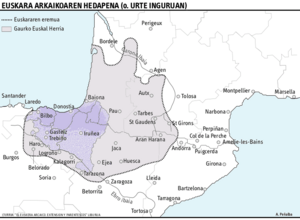Late Basquisation facts for kids
Late Basquisation is a different idea about when the Basque language arrived in what is now northern Spain. Most people think Basque is a very old language. They believe it's one of the last languages left from before Indo-European languages spread across Europe.
However, the Late Basquisation idea suggests that the first Basque speakers came to the Iberian Peninsula (modern-day Spain and Portugal) from Aquitaine (a region in France) much later. This would have been around the 5th or 6th century AD, which is about 1500 years ago.
Contents
Understanding the Basque Language
The Basque language is quite special. It is a language isolate, which means it's not clearly related to any other known language family in the world. Think of it like a unique tree in a forest of many different kinds of trees.
Basque has survived even though many Indo-European languages spread across western Europe. In the past, Basque and its older forms, like Aquitanian, were spoken in a much larger area. This area included parts of modern-day France (like Béarn and Gascony) and parts of Spain (like Aragon, Rioja, and Castile).
What is the Late Basquisation Idea?
The "Late Basquisation" idea suggests that the Basque language spread to its current areas later in history. It proposes that Basque speakers moved from Aquitaine (in France) into northern Spain. This movement happened at the end of the Roman Republic and during the early years of the Roman Empire.
This idea suggests that the people already living in northern Spain spoke Indo-European languages. The migration of Basque speakers from Aquitaine grew over time. It reached its peak in the 6th and 7th centuries AD.
A Spanish language expert named Francisco Rodríguez Adrados supported this idea in 2008. He suggested that Basque was spoken in Aquitaine before it was spoken in the Spanish Basque Country. He believed that the pressure from Celtic invasions caused Basque speakers to move south.
Evidence for Late Basquisation
The Late Basquisation idea points to several pieces of evidence. These suggest that the current Basque Country had a different population before Basque speakers arrived.
Here's some of the evidence:
- Old Indo-European Names: Before the Romans arrived, there were many old names in the area that sounded Indo-European. This suggests that Indo-European people lived there first.
- No Early Basque Traces: There are not many signs of the Basque language in this area before the Romans. This is different from Aquitaine, where older Basque traces are found.
- Roman Influence: The Romans had a strong influence on the Basque region. This deep Romanization suggests that the local people were not isolated, but part of the Roman world.
- Basque Language Spread: The Basque language seemed to spread out during the Early Middle Ages. This expansion could mean it was moving into new areas.
- Similar Basque Dialects: The different forms of Basque (dialects) were quite similar in the Early Middle Ages. This might suggest they spread from a common point more recently.
- Archaeological Finds: Discoveries at places like Aldaieta and Alegría show changes in cultures over time.
- Genetic Differences: Studies of human genes by Luigi Luca Cavalli-Sforza show a clear genetic line between Basques and their southern neighbors. However, the line is less clear with their northern neighbors. This could mean Basques moved south from Aquitaine.
See also
 In Spanish: Vasconización tardía para niños
In Spanish: Vasconización tardía para niños


